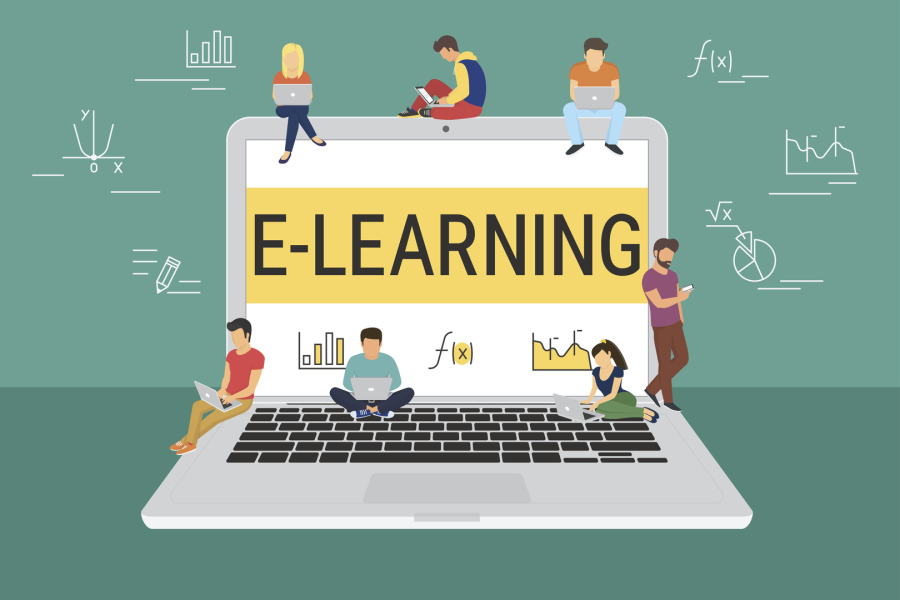Ed Tech Blog

As EdTech continues to revolutionize traditional teaching methodologies, e-learning platforms have emerged as pivotal tools in promoting accessible, personalized and engaging learning experiences. However, with a myriad of options flooding the market, it can be daunting to select the right fit. In this post, we'll review and compare some of the top choices to aid your decision-making process.
1. Google Classroom
Google Classroom, part of the Google Workspace for Education, facilitates quick assignment creation, distribution, and grading. The platform is seamlessly integrated with other Google tools like Google Docs and Google Drive.
Advantages: Easy-to-use, versatile, excellent collaboration capabilities, and it's free for schools.
Disadvantages: Lacks a comprehensive built-in student assessment system.
2. Canvas
Canvas is lauded for its open, intuitive design and cloud-based system. It provides features such as content sharing, grading, feedback, and integrates with numerous educational apps.
Advantages: High customization, seamless app integration, and robust community support.
Disadvantages: The learning curve for newcomers, and advanced features can be overwhelming for some users.
3. Moodle
As a free and open-source platform, Moodle provides various tools for collaborative learning. It boasts features like forums, databases, and wikis to create customizable courses.
Advantages: High levels of customizability, extensive plugins, and add-ons, and it's open-source.
Disadvantages: Requires technical expertise for setup and configuration, and the interface isn't very intuitive.
4. Blackboard
Blackboard, one of the pioneers in the e-learning industry, offers interactive learning experiences with features like data reports, grading, and customizable assessments.
Advantages: It's feature-rich, offers various learning modules, and has built-in student assessment capabilities.
Disadvantages: The user interface isn't as friendly as others, and it can be costlier than competitors.
5. Coursera
Coursera partners with top universities and organizations worldwide to offer online courses, professional certifications, and complete degree programs.
Advantages: Accessible high-quality content from renowned institutions, diverse offerings.
Disadvantages:
Read more: E-Learning Platforms: A Review and Comparison of Top Choices
In our evolving digital age, technology-driven education, or EdTech, is revolutionizing the traditional landscapes of learning across the globe. From personalized learning tools to massive open online courses (MOOCs), EdTech is unlocking new realms of global accessibility, interactivity, and inclusivity in education. However, with the expanding reliance on this growing field, the significance of potential cybersecurity risks escalates. This dependence underscores the urgency to comprehend the importance of cybersecurity within the realm of EdTech and to be proactive in applying the best practices.
Understanding the Importance of Cybersecurity in EdTech
As reservoirs of extensive and sensitive information, education institutions manifest as attractive potential targets for cyber threats. With the integration of EdTech solutions, cybercriminals seize opportunities to exploit any breaches in security systems. The imperative nature of EdTech platforms' security is crystal clear in our current digital education environment.
The criticality of cybersecurity in EdTech primarily revolves around these key aspects: data privacy, system integrity, and student safety:
1. Data Privacy: Educational institutions manage a trove of sensitive information, encompassing personal details, academic records, and financial data of students, faculty members, and administrative staff. An absolute assurance of data privacy is paramount to the survival, sustainability, and trustworthiness of these...
Read more: Cybersecurity in EdTech: The Crucial Role and Best Practices

In an era ruled by smartphones, the introduction of mobile learning or m-learning in educational technology (EdTech) is revolutionizing learning experiences. Here's how the transition to small screens is shaping the education sector:
1. Ubiquitous Learning:
Learning is no longer constricted to classrooms or desktop computers. With educational apps, e-books, video lectures, and interactive exercises on mobile phones, students can now learn anywhere and at any time, making education truly ubiquitous.
2. Personalization:
Many mobile learning apps offer personalized learning paths based on the learner’s abilities and preferences. Artificial Intelligence (AI) algorithms analyze a learner's progress and automatically adapt content to suit their pace, understanding, and performance levels.
3. Gamified Learning:
Mobile EdTech has successfully gamified learning. Apps with multiplayer quizzes, puzzles, simulations, and digital rewards have made learning interactive and fun, thereby increasing student enthusiasm and participation.
4. Diverse Learning Materials:
M-learning provides easy access to a wide array of content through podcasts, videos, infographics, and text, all in the palm of your hand. This variety caters to different learning styles and needs, enhancing the overall learning experience.
5. Peer Interaction:
Many mobile learning platforms incorporate social learning features, allowing learners to collaborate, discuss and learn from each other.
Read more: The Mobile Learning Revolution: EdTech on Your Phone

Over the past several years, an emerging digital revolution has completely disrupted and dramatically transformed the educational landscape. This transformation is grounded in a phenomenon often referred to as Educational Technology, or EdTech, which has steadily taken on the mantle of defining the direction of future classrooms. EdTech is no longer an optional extra, but an essential component of modern learning. Its influence radiates across every facet of teaching and learning, from the amplification of the traditional classroom setup to becoming a pivotal platform for distance learning. The diversity and relevance of EdTech are ever-evolving, becoming more critical with each passing day.
So, what does this technological metamorphosis mean for the future of education? Let's delve deeper into the progressively vital component that modern education has come to rely on.
1. Personalized Learning Experiences:
One of EdTech's most exciting offerings is its undeniable potential for personalization in learning. Adaptive learning systems, one of the shining stars of the EdTech repertoire, curate a unique educational experience that is tailored for each student on an individual level. It aligns with their pace, comprehends their context, and responds to their distinct learning style. In a very real sense, such systems create a personal...
Read more: The Future of Education: An In-depth Exploration of EdTech’s Role in Modern Classrooms

Generation Z—those born after the mid-to-late 1990s—are digital natives who have grown up in a world of smartphones, social media, and constant connectivity. To engage this dynamic generation, education needs to be as interactive, collaborative, and tech-savvy as they are. Enter game-based learning, a potent aspect of educational technology (EdTech), perfectly suited for engaging Gen Z. Let's explore why.
1. Immersive Experiences:
With game-based learning, education transcends traditional lecture-based instruction. Games can take students on historical adventures, scientific explorations, or mathematical quests, captivating them with immersive experiences, storylines, and challenges.
2. Boosts Engagement:
Games by their nature are engaging, and applying that to education has the same effect. Game-based learning mixes fun with instruction, keeping Gen Z learners invested in their educational journeys, thereby improving their concentration and intrinsic motivation.
3. Enhances Retention:
Game-based learning promotes active participation, pushing students to apply the information they've learned to solve problems or reach in-game goals. This process improves knowledge retention and understanding of complex subjects.
4. Encourages Collaboration:
Multiplayer educational games foster teamwork. Gen Z, known for valuing collaboration and social consciousness, can work together, share strategies, and learn from each other, promoting a healthy, collaborative learning environment.
5. Instant Feedback:
Most...

In our present digital era, data has become a fundamental element for smart decision-making and strategic planning across all sectors, including education. As an invaluably effective tool, data analytics in education has the capacity to dissect and analyze complex data sets, revealing significant insights regarding student performance, teaching methods, and curriculum efficiency. This investigation takes a deeper look into the vast and transformative impacts of data analytics upon the world of education.
1. The Advancement of Personalized Learning:
Data analytics has revolutionized the way we approach education by allowing for a highly customized learning experience. By analyzing complex algorithms from data sets, educators can tailor curriculum and learning paths that cater to individual learning capabilities, pace and performance. This breakthrough in adaptive learning provides an effective way to enhance the teaching process and offers students a more rewarding and personally tailored learning experience. Moreover, personalized attention to student needs has the potential to foster greater student engagement, thereby promoting an increased retention of information.
2. Proficient Tracking of Student Progress:
Data analytics sheds light on student progress over fluctuating periods, offering an unparalleled insight into student development. Not only does this help educators pinpoint specific areas where a student may...
Read more: Breaking Down the Transformative Impact of Data Analytics on Education
